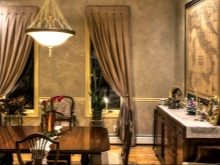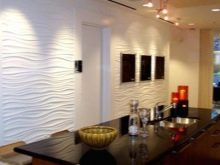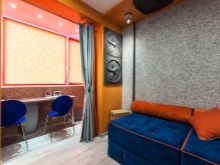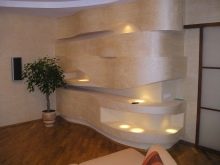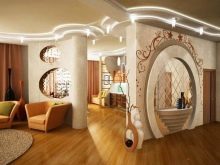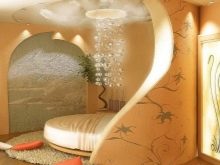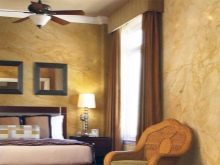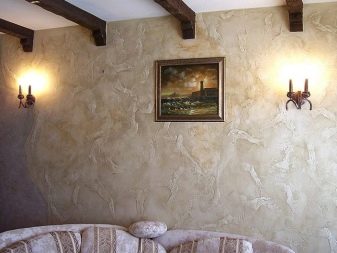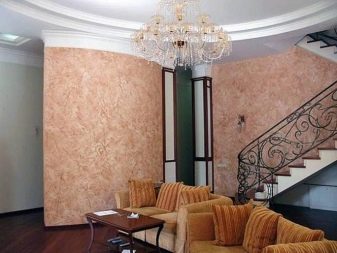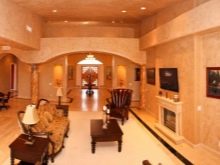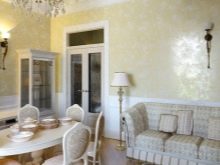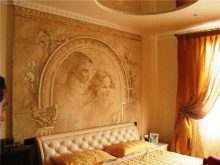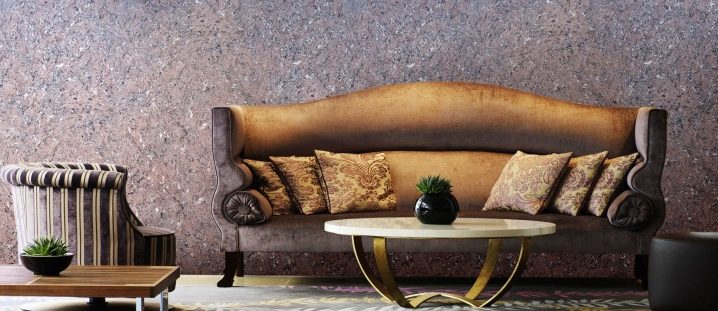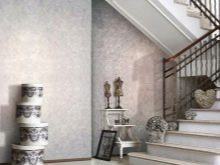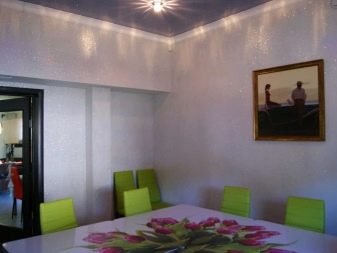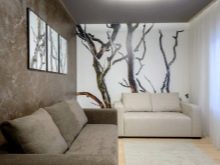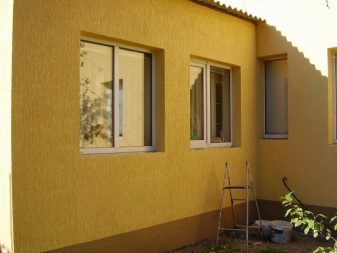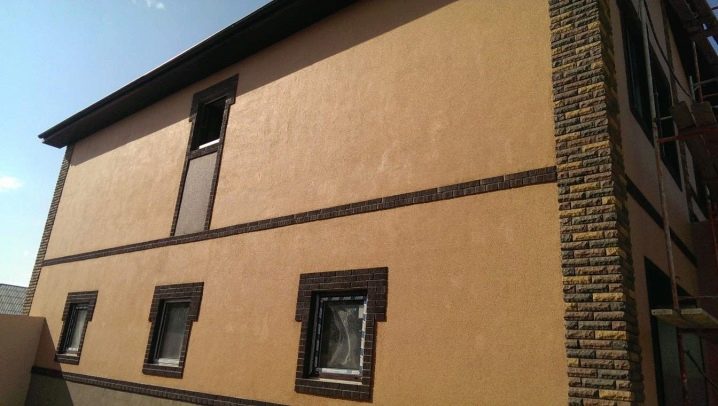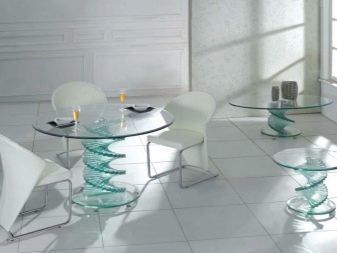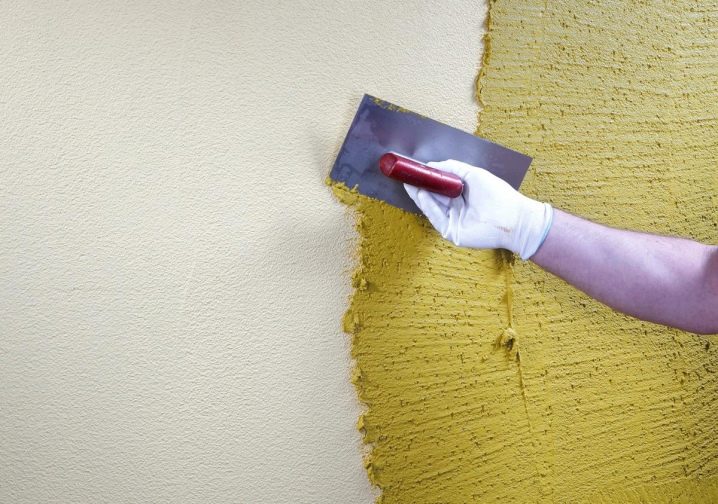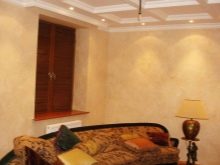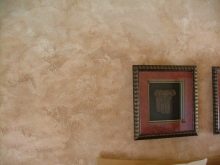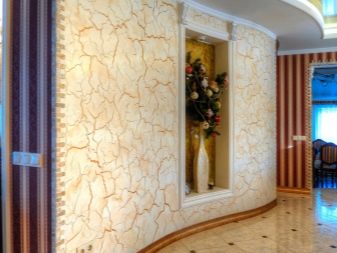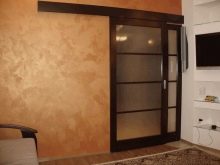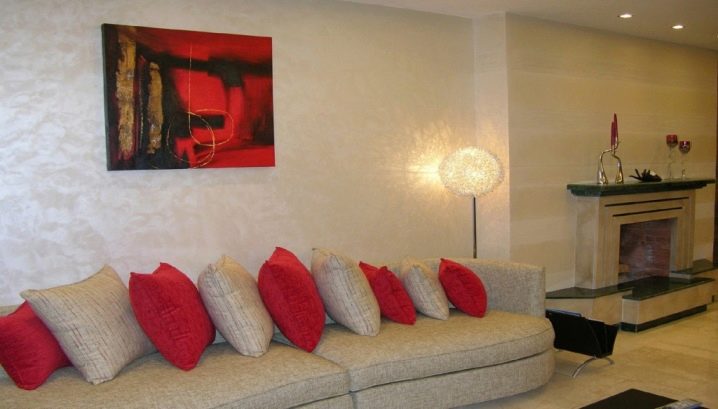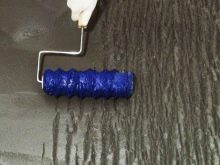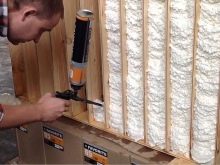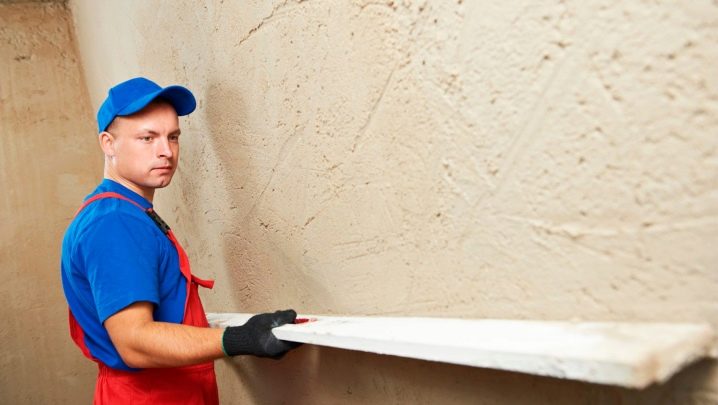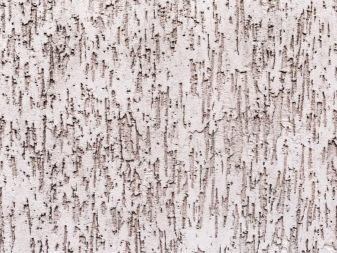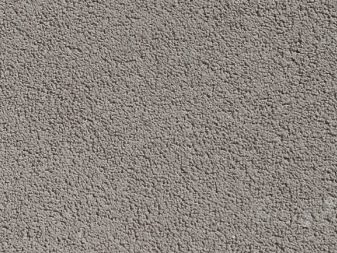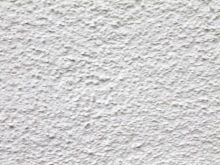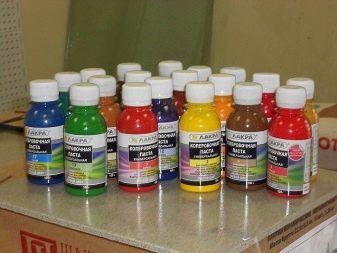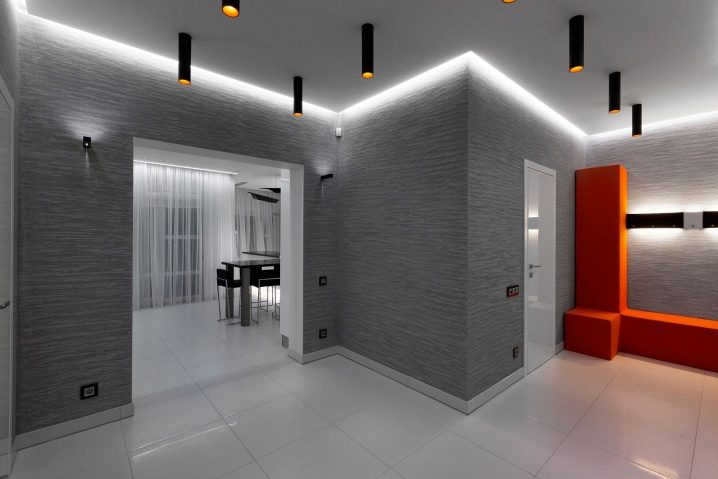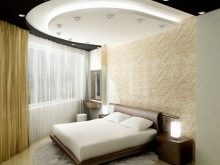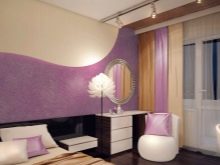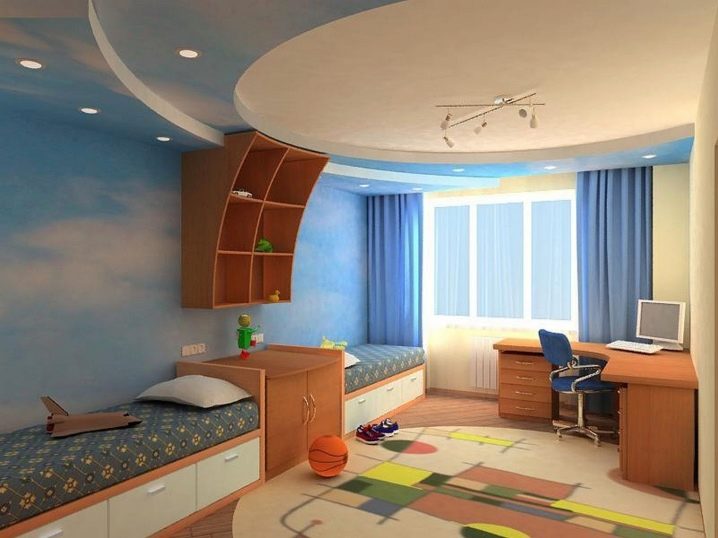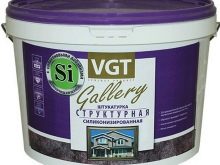Decorative plaster: beautiful options for wall decoration in the interior
Decorative plaster - an interesting solution that allows you to perform a beautiful finish of the walls in the interior. There are many options for how to apply this plaster. In each case, an unusual and unique effect is obtained.
Special features
Decorative plaster for walls began to be applied now more often than before. This is due to the advent of fashion for everything natural, and it is this coating that allows you to skillfully simulate the surface of a stone, wood, even animal skin or reptiles. The material differs from the usual plaster in the presence of special additives, which are responsible for such unusual decorative features and the final appearance of the coating.
This tool is used not only for interior walls.
You can often see new buildings, lined with decorative plaster mix. For work outside use special formulations - front. They are well tolerated and weather changes, and mechanical stress.
Decorative plastering compositions are quite specific., as a result, it becomes possible to create patterns, reliefs on the surface. There are many types of material, each of which has its own characteristics. However, all decorative plasters have something that unites them - the price. It cannot be called low, and for some materials it is altogether excessively high. However, the result is worth it.
Advantages and disadvantages
Decorative varieties of plaster compositions differ in their advantages and disadvantages. However, there are general provisions for all kinds.
Benefits include:
- Big variety. You can choose different types of plaster in both color and texture. There is an opportunity to create any bas-relief - the choice is practically unlimited.
- The possibility of using various impregnations and coatings.Plaster can not only be painted, but also covered with a composition to impart special properties. Popular is wax, which adds to the surface of the walls of a moisture-resistant film. As a result, the walls become washable, which is extremely important for some rooms.
- The plaster is easy to apply, with the exception of a few "capricious" species. The simplicity of working with it is an important advantage.
- Decorative plaster coating well hides all defects on the walls.
- Inside the room, decorative plaster will serve as a heater, but this requires compliance with several conditions: the use of quality material, the choice of the composition of the desired class, pre-priming the walls.
- Decorative plaster composition is environmentally friendly, so it can be used in rooms where children live.
In addition to these advantages, there are decorative plaster and cons.
However, there are no common drawbacks for all species, since in each of the varieties certain deficiencies are leveled, but others appear.
Need to look at the type of putty.
Kinds
There is a wide variety of types of decorative plaster.They can differ in the type of base, in the effect, which is obtained in the end, in texture, in the substances used in the composition and in many other factors.
As a rule, by name it is possible to judge what effect will be obtained as a result of applying the coating, or what it is made of. For example, when hearing about lime plaster, a person immediately realizes that it is made on the basis of lime and, most likely, has a white color. However, things are not always so simple. A simple man in the street, having heard shagreen, about plaster, will not understand anything, while a professional will immediately present a surface with a small wavy relief.
Decorative compositions are available in two forms. The most convenient to use and apply the finished paste.
All you need to do is open the container and start working. Another thing is dry mix. There will have to spend time and effort on her breeding. It is important to ensure that the solution does not turn out to be too thick or too liquid, as this will cause the coating to fall wrong.
Some varieties are easier to apply, others more difficult. The easiest to apply is cement plaster.Unlike gypsum counterparts, it does not set so quickly, so there is plenty of time to fix all the flaws. Beginners should choose this option.
Structural
Structural plasters are a common name for all the variants with which they form patterns on the walls by hand. In the process of applying or drying the solution does not take any specific form, the surface does not become relief, but the texture of the plaster is such that any bas-relief can be created on the surface. The compositions are well suited for creating three-dimensional panels, styling for any natural material and so on. As a rule, structural decorative plaster can be painted or varnished. This makes the effect of simulating other material more reliable.
When working with structural plaster using a variety of tools. Apply not only specialized samples, but also available materials. Often, the usual household items used at home every day, allow you to get even more interesting results than painting tools.
Structural plasters remain one of the most popular. You can vary the color at will by adding a suitable color scheme. It is even possible to add glitter to the composition - crushed polyester film of various colors, which ultimately makes the surface shiny. The choice of all kinds of scenery is huge.
Mineral
Mineral plaster is made on a mineral basis, hence the name. It is distinguished from all others by a slightly coarse texture, due to the content in its composition of crushed particles of various minerals, such as granite or marble.
The mineral variety has a number of features that can be perceived as advantages or as disadvantages depending on the situation. One of these characteristics is the quick setting of the solution. It is necessary to work with such compositions promptly, otherwise it will not work to eliminate flaws.
Another feature is versatility. Mineral plaster can be used both for interior work and for exterior work. The surface is seamless, which is very convenient, especially when plaster of several colors is used: the joints are clear, pronounced, but at the same time it does not affect the topography of the coating.
The most common plaster received when covering plasterboard partitions.
It perfectly adheres to this material, as a result the layer turns out to be saturated and relief, all possible cracks and irregularities are well concealed. Variants that mimic granite or quartz chips are used more often than others. The undoubted advantage is the fact that the mineral plaster compositions do not need a finishing layer.
Textured
A distinctive feature of textured plasters is the presence of any texture in the composition. For example, you can recall the well-known coating craquelure, which in the process of drying as it cracks. Beautiful cracks are created in the upper layer of the material, and through them a different color of the coating is visible. The effect of aged walls can be achieved when gold shines through cracks, which is so characteristic of the classic or baroque styles.
For textured plasters often choose different fillers: fine-grained structure is obtained by adding small pebbles or shells, an interesting effect can be achieved by adding mica or natural wood fibers - the surface becomes more voluminous,and the view of a room with such walls is more interesting.
There are three types of textured plaster:
- flat surface with a variety of colors;
- relief with a finished drawing;
- relief with an arbitrary pattern.
In the first case, the wall itself is made even, and the volume is added using color accents, playing on contrasts, and using special color schemes.
In the second variant, the bas-relief is created by plaster, even it is not necessary to try: when the plaster dries, everything will turn out by itself.
In the third case, resort to the use of special devices - special rollers. The plaster is made to such a consistency that the pattern remains clear after rolling with a roller.
Venetian
Venetian plaster is the most difficult to apply. This is due to the subtlety of work. First, the difficulty lies in preparing the walls. They must be pre-aligned, and a deviation of no more than 3 mm per square meter is allowed.
Plastering work must be performed by a qualified and experienced craftsman. "Venetian" put in 5-7 layers, but their total thickness should not exceed 3 mm.
The work uses a variety of equipment: spatulas of various sizes and more. The surface as a result turns out smooth, with modulations, most of all reminding marble.
This option of plaster material is the most expensive of all listed. This is due to the expensive raw materials used in production. In ancient Rome, masters used marble dust and other industrial wastes to clad their dwellings, but now the latest developments are used. Plaster has become much cheaper, but the price still can not be called democratic.
It should be borne in mind that the Venetian plaster is transparent: it will be necessary to additionally purchase a color scheme of the desired color.
Also be sure to need the application of the finishing layer. Here it is best to use wax, which will give the surface an extra glossy shine. It is impossible to paint the Venetian plaster, otherwise the whole effect will disappear.
Flock
Flocky look is also often called silk because of the excellent imitation of the surface of silk or velor. When using this type of finishing material, the room takes on an exquisite aristocratic look.
Classic flock plaster can not be attributed to waterproof,it is commonly used in living rooms, such as the bedroom and living room.
To the touch this variety is smooth, but warm. It can be compared with ordinary wallpaper. The material is natural and environmentally friendly, and this is due to its many positive features, one of which is vapor permeability. Due to this, the walls covered with flock plaster are not affected by fungus, mold or other microorganisms. There are special moisture resistant varieties that can decorate the walls of bathrooms.
Among other things, the advantages include the ease of working with this material. It is easy to apply, no specific knowledge or special skill is required. In addition, a wall covered with a flock plaster can be partially repaired - it will not be necessary to completely renew it. Thus, the choice of flock plaster is one of the best options if the repair in the house is done by an inexperienced master.
Polymer group
Polymer plasters - a generic name for plasters by type of binders. Thus, the polymer group includes acrylic, silicate, silicone and siloxane plasters.Polymer materials are very easy to use, because before applying them you do not need to prepare the walls too carefully. Basically, these are white solutions, but you can add different colors to them, varying the color to your liking.
Polymeric compositions are applied in 1-3 mm thick layer. Of course, such a coating will not be able to hide too strong flaws, such as deep cracks or holes, but successfully closes minor defects. Add water to the finished composition can not, even if it began to dry out. Dry plaster is not sold. You can buy only the finished mixture.
On the one hand, it is convenient, because you do not have to calculate the proportions, dilute and stir the mixture yourself.
On the other hand, ready-made mixtures are much more expensive, and often have to refuse to buy because of the high cost.
The texture of the surfaces is created manually. After drying, it remains initially formed.
A special stage is the finishing treatment. Polymer plaster compositions do not require such, but will have to "walk" a little on the surface with emery paper.
Acrylic
This name combines several varieties of plasters, based on each - acrylic resin.Acrylic variants are used both for facades and for interior decoration. Materials are already sold in ready-to-use form: they do not need to be diluted with water. Immediately after the purchase you can start finishing work. Usually, acrylic plaster is mixed with foam, because it practically does not allow evaporation, that is, the walls treated with it do not “breathe”.
Acrylic decorative plaster compositions have many advantages. One of them is the long service life of the finished coating, which can be up to 25 years. Due to the high elasticity of the material, all irregularities and small cracks are masked, as well as other minor flaws. Stucco helps prevent new blemishes. This quality is inherent both to materials for internal works, and for external. Decorative plaster on acrylic base qualitatively protects the walls from mold and mildew.
Another advantage is the high degree of adhesion: the material adheres well to the walls.
Silicate
There are plaster and disadvantages. In particular, it easily ignites, so it should not cover the walls in the kitchen.The material does not belong to antistatic, so dust and other contaminants will easily settle on it. However, the walls can be washed with water: the plaster can easily tolerate high humidity and exposure to water.
Silicate options are mainly used for exterior cladding, but there are no contraindications to their use in interior decoration. In the living rooms such decorative plaster is not used, but they can often be seen on the walls of the kitchen or balcony. The material is environmentally friendly. Silicate plasters are sold immediately in finished form: for example, they can be used immediately after purchase.
The material is based on the so-called “liquid glass”, due to which it has acquired increased wear resistance.
The advantages of such compositions include:
- good adhesion to different surfaces;
- the ability to pass air;
- no deformation during use;
- resilience to climate impacts;
- lack of smell;
- high elasticity;
- anti-static;
- fire safety;
- ease of operation and others.
However, there are also disadvantages:
- Extremely fast adhesion, resulting in work that needs to be done promptly. For a beginner, this may not be possible.
- Mandatory preliminary surface preparation.
- Relatively short service life.
There is also a combined option - silicate-silicone mixture. It has improved performance: lasts longer, more resilient and more.
Silicone
Silicone plaster - the name generalizing as a basis. This variety appeared on the market relatively recently, but immediately won the love of consumers. Silicone version is universal. It is suitable for both interior and exterior. All this is due to a unique set of characteristics.
Silicone mix at the same time and qualitatively levels the coating, and serves to decorate it.
Among other things, it is a good antistatic. Dust against such walls is not attracted. This is especially important when building the exterior of a building. Even if a motorway runs nearby, dust will not settle on the walls of the house.
Silicone plasters often outperform all other samples. for durability and wear resistance, which partly affected their wide popularity.Special preparation of the walls before application is not required, it is enough just to rid the original surface of the old coating. The surface can be painted or add color to the plaster. The cost of plaster is determined by the brand, type (ready mixture or not) and what characteristics are needed - for interior or exterior use.
Smooth
Plasters with a smooth invoice are often chosen by designers in the design of living rooms. This is due to the fact that in this case it is possible to shift the focus from the plastered walls to something else, for example, to an interesting piece of furniture. The texture without relief does not seem boring, because the plaster can imitate various coatings: velvet, velor, silk, leather - the choice is as great as when using textured plaster.
Obviously, exquisite Venetian ones belong to smooth plasters.
However, other smooth decorative plaster look a little different. Some of them still have a noticeable texture, but it is important to take into account when choosing that texture and mother of pearl are not combined with each other. If you want the walls to look stylish, tastefully decorated,then choose the option without gloss or overflow, if the plaster is at least a little grainy or nacreous, or the coating promises to be perfectly even.
Smooth decorative coatings require perfect walls before applying: the surface must first be carefully prepared.
It is necessary to remove even the smallest cracks, because the smooth plaster does not mask the flaws, on the contrary, they emphasize. As a finishing layer, wax is used, which at the same time protects the surface from moisture, and gives it extra shine.
Colored
Most decorative plasters are sold in plain white. In the future it is implied either their painting or the addition of color to the composition. However, there is on the market and such a phenomenon as colored decorative plaster. In the case of their use, the color of the coating is guaranteed to be uniform and saturated, while adding a color scheme does not risk mixing the mixture very carefully, having obtained a surface with stains. A significant minus of colored plaster is high cost compared to classic whites.
Typically, colored decorative compositions are selected when decorating a room inclassic style, but if you choose the colors correctly, you can make the interior in high-tech, modern and other styles. Color textured plasters are most often chosen. With their help, unusual textures are created: Moroccan, Versailles and many others.
Often you can see the murals created with colored plaster compositions.
When choosing worth paying attention to the expiration date. It is better to use a fresh composition, while with plaster with an almost expired shelf life it will be difficult to work - it will lose some of its original qualities.
Scooters
Roller plaster is the most popular.
This is due to several factors:
- It is easy and simple to work with her, for which professional masters “love” her.
- The pattern obtained on roller coats is familiar to everyone - this is the so-called “bark beetle”. The texture is a pattern of many grooves of different thickness and depth, and the grooves can be placed as you like. The covering as a result reminds a piece of wood, eaten by a bark beetle.
The mixture is not sold ready. It must be diluted with water.
The shelf life of the prepared solution is extremely small: it must be used on the very first day after preparation - after two days it freezes completely, turning into stone.
The surface treated with roller plaster can be sanded. You can simply smooth out the sharp corners on the plastered walls, or you can correct or even improve the pattern, make it more pronounced.
"Bark beetle" is used for both exterior cladding and interior design - roller plasters are universal. As a rule, they are sold for painting, so the addition of color to the composition is usually not provided.
Latex plastic
Decorative latex plasters are relatively new on the plaster coating market. This is a polymer-based material with various modifying additives. Plaster latex-plastic has a high degree of adhesion, water resistance, resistance to cracking, high vapor permeability, ease of application. The material is tinted with the help of special highly concentrated pastes. After sanding, the latex plaster begins to glitter and shine a little.
Walls treated with this composition can be washed. They are not afraid of direct exposure to water.
This makes it possible to design the walls of the bathroom with this option. To increase the moisture barrier qualities, wax is additionally applied to the surface. It also makes the surface more shiny.
There are many options for applying such plaster. Among the possible and imitation of tiles, and the creation of a variety of patterns and ornaments - colored or monochrome, and texture coating, and smooth, and matte, and glossy. The only disadvantage is that the material is not complemented with sparkles, however, the gloss after treatment with a metal tool is usually sufficient.
The material dries completely in two days, and fully gains strength in two weeks. Before the expiration of the two-week period, water should not be applied to the decorative plaster of latex-plastic.
Wet silk
Wet silk decorative plaster is similar to the flock decorative variety, but these materials are not identical. Here the composition of the plaster includes fibers of artificial or natural silk, due to which an interesting pressed texture is achieved.
Wet silk plaster is not very commonbecause it is quite expensive. Price depends on the type of fiber added. Options with the addition of natural silk will be several times more expensive than samples with the addition of artificial. In addition, these walls will not look good in every room. For example, if a room is decorated in the style of a loft or Provence, the silk walls will look ridiculous. The covering is more combined with classical interiors: baroque, classicism, sometimes art deco.
The walls do not appear plastered, but covered with silk fabric. The larger the fibers that make up the plaster, the more expensive the coating looks.
Decorative “wet silk” plasters are represented by a large color variety, so there will be no problem of choosing the right one for the tone. There are options, which additionally includes sparkles. This is done in order to make the surface more striking, it is possible to assign an accent role to the walls.
Sea breeze
Stucco-paste "sea breeze" has several distinctive features. So, the paste itself is not just white, but pearl.The composition also adds fine river sand to make the coating more textured. Its texture is translucent, so that the walls do not seem to be "dense" and "heavy." It is used not only in ordinary apartments, but also in offices, hotels and other public institutions.
Plaster is not painted and tinted, but originally bought in color. Depending on the manufacturer, the color range varies. Shades of precious metals are usually chosen. The paste is waterproof, so it can be used to finish both the walls of bedrooms, living rooms, children’s rooms, and bathrooms.
The time to build strength is two weeks, and the paste dries in two days.
It can be stored in a closed container at a temperature not lower than -15 degrees, otherwise the decorative “sea breeze” plaster loses its properties.
It is interesting that after applying the putty itself, the sand that is part of it needs to be distributed over the surface not evenly, but in groups, thereby creating an unusual effect. The work on the formation of sand pattern should not be done immediately on the entire area of the wall, but after applying putty on a small area.So that the joints could not be seen, one should not leave boundaries straight. It’s best to make them ragged.
Colors and design
Usually decorative plaster is made in white color, however options are possible. The color variety is immediately colored. If you could not pick up the ready-made composition of the desired shade - it does not matter, because you can always use tinting pastes and compositions. For example, not only light supplements, but also dark ones are very popular: blue, brown, purple, turquoise, green, and a number of others.
It is possible to combine two or more colors at once. Of course, the first to come to mind is the creation of various panels and frescoes.
The effect of antiquity can be achieved by applying patina. Patinating is one of the favorite methods that can be performed not only with classic gold and emerald green, but also yellow, gray and other non-standard shades. This decor looks interesting and luxurious, but only on condition that the color duets are chosen correctly.
With the help of various tools you can recreate various patterns on the walls: roses, stripes, circles, raindrops.To do this, it is not always necessary to purchase special tools, sometimes it is enough to use what you have at hand, for example: sponges, plastic bags, rubber gloves, combs and so on.
Application Tools
To work with smooth and textured plaster you will need the same tools, but in the first case you can limit yourself to only one (for example, with a brush or roller), and in the second you need to look at the whole set.
For work you will need:
- Drill and special mixing nozzle. Manually mix the solution for optimal application does not work, it is best to use the device. So the mixture will be homogeneous, it will be smoother.
- Wide, medium and narrow spatulas. These tools are necessary for leveling plaster fabric. In the case of Venetian plaster, each of 5-7 layers must be applied with a spatula of a different width. Also, spatulas will be useful for imparting some simple drawings.
- Trowel, also called trowel. Patterns that are made with a trowel can be applied with a trowel, but the trowel will be faster and easier.
- Rollers.There are several types, each of which allows forming a special pattern on the surface. Sometimes they first make one drawing, and put another on top of it (for example, they first treat the surface with a foam roller, and then with a relief).
- Rubber or plastic embossed. Initially, ornaments are carved on them, and they can be both seamless and border.
- Fur. It turns out an interesting granular texture, reminiscent of protruding wet fur.
- Foam rubber. This roller can be applied fine-grained pattern.
Additional materials
Not all varieties of decorative plaster need to be pretreated and leveling the base, but it’s better not to neglect this step so that the resulting pattern is brighter, the coating keeps better and does not fall off the wall. Before it is necessary to close up large gaps and cracks. In some cases, you need to use such building compositions as polyurethane foam or even ordinary plaster. Be sure to handle the deep cracks and crevices as best as possible, and later level the wall surface.
ATIt is important how the plastered coating will be treated. The finishing layer is usually provided. Can be used as paints, giving color, and transparent options. Finishing additionally protects the walls covered with decorative plaster from moisture or mechanical damage. However, the topcoat can play just a decorative function.
There are special additives and thinners that serve decorative purposes. They allow you to change the texture a little, and sometimes they make it so that after drying on the surface a pattern is formed without any effort from the master. The effects obtained in this way can be extremely interesting.
Starting plaster
The starting composition is used for leveling the surface of the wall, preparing it for applying a decorative coating. On a flat wall, it is easier to recreate the pattern that is needed, so this step is considered mandatory, regardless of what kind of decorative plaster is chosen.
As well as decorative plaster, starting are on polymer or mineral-based.
It is important to coordinate that both the decorative and starting mixtures are on the same basis.Only in this way will the maximum adhesion of the mortar to the surface and the compositions with each other be guaranteed.
Plaster-based starter plasters are popular.however, beginners should refrain from their use. The mixture sets in extremely quickly, so all work with it must be carried out promptly. Cement-based mortar is better suited to those who have not dealt with such work. There are also earthen starting plasters that are excellent for preparing wooden walls, but when working with plasterboard, concrete or brick walls you should choose more modern materials. Anyway, the basis should be the determining factor in choosing the starting lineup.
Compositions for decoration
To create a relief, patination apply a variety of mixtures that are added to the decorative plaster or applied on top of it.
As an example, the following options:
- Additive to create effect "Bark beetle". Granular additives are taken, the fraction of which is 2.0-3.5 mm. The base can be any, however, the mineral fraction size is larger than the polymer.
- "Kameshkovaya" the additive creates an interesting effect, resembling the surface of the cleaved gypsum. The fraction is chosen very small - 1-2.5 mm, and usually the additives of different fractions are mixed to get the most believable look.
- "Mosaic" texture is achieved through the use of additives not only of different fractions, but also of different colors. It looks more impressive if you take the additives of the same color, but in different colors, for example, dark brown, sandy, beige and reddish brown. Fractions can be taken the same, but different ones can be: the sizes range from 0.8 mm to 2 mm.
- "Fur coat" - a special kind that is applied using a fur roller. To enhance the relief in plaster add special tools that make the relief "under the wet fur" more clear.
- "Lamb" - fine-grained additive. The result is a rough texture. This option is often chosen when designing corridors or hallways, because it is not very pleasant to the touch.
Primer
Primers are sold both in the liquid state and in the pasty form. They are not always necessary, however, under some types of plasters (smooth, especially Venetian) they need to be applied.Primer is used before applying the starting plaster, so that it grappled with the wall as best as possible. Antiseptics are added to the composition to prevent fungus and mildew.
The primer is applied to the layer of starting plaster. In this case, it improves the relief and adhesion of the decorative plaster composition.
It should be borne in mind that if under the starting layer it is better to choose liquid primers of deep penetration, then a primer-paste will be suitable for a decorative one. Each of the layers must be thoroughly dried, otherwise the plaster will soon crack and collapse.
If you have done without the use of a primer, be prepared for the fact that it will take more effort to mask the irregularities of the wall. It also does not make sense to carry out priming work, if soon it is planned to replace the decorative plaster with any other wall covering. The primer significantly increases the durability of the decorative plaster layer.
Coloring agents
These include all kinds of colors, glitter, paint. On each of the species you need to tell a little more detail:
- Kolery are pasty or powdered.They are added just before applying the plaster. Plus of use that it is not necessary to take care of giving of the necessary color further. But there is one significant disadvantage here: it can be difficult to achieve the same shade of different portions of decorative plaster, so you have to immediately paint the composition in full and cover and decorate all the walls in one go.
- Glitter and Glitter added to decorative plaster to give it shine. Depending on how many of them will be added, it depends on how much the mother-of-pearl walls will be. Perhaps you need a modest unobtrusive shine, and maybe a bright play. Glitter comes in different fractions: small and large. There are also shiny fibers.
- Paints - The most simple and familiar option. Special solutions should be selected that are suitable for machining plastered surfaces. Of the minuses - only the duration and thoroughness of the work, otherwise painting is the least risky finish regarding the uniformity of color.
Lucky and waxes
These materials are usually transparent. They are used to add radiance, protection from moisture and heat.Please note that lacquer or wax cannot be used for decorative plaster coatings with deep relief, since the whole surface cannot be worked through, so wax or lacquer should be chosen for smooth or almost smooth.
Like paints, varnishes are matte or glossy. Varnish is not applied in a single layer, preferring to use 2-3 layers.
This helps not only to better protect the surface, but also to help with the imitation of certain patterns, such as crocodile skin, stone surface, and so on.
Wax is traditionally used as a finishing layer for Venetian plaster. It has only a practical function - it protects the coating, but it still gives some shine and radiance.
Wax well passes air, unlike a varnish, the surface beneath it "breathes." This makes wax versatile, allowing it to be used both in residential and residential rooms. Wax at times improves the water-repellent characteristics of the coating, so they can cover the walls and in the bathrooms.
Masking tape
Paint tape is used when zoning walls. It so happens that part of the wall will be covered with decorative plaster, and the other - with something else, for example, covered with wallpaper.However, the most important thing for which the tape is needed is to protect the surrounding surfaces from contamination with decorative plaster. So, having pasted over a fireplace, door jambs, a floor closely against a wall or a ceiling, it is possible to save them from casual damage that will save considerable forces and financial means for their cleaning or updating.
How to choose?
The choice of decorative plaster should primarily depend on what kind of room you want to see in the end. It often happens that you want to create a high-tech interior, but it is not clear why the choice falls on the Moroccan or Venetian coating. It is important to harmonize the required and the resulting form.
Another condition affecting the choice - the environment.
Some coatings are subject to specific requirements depending on the room that they issue:
- So, for living rooms: bedroom, living room, child - it is important to pay attention to the environmental friendliness of the material, its safety, then how comfortable it is to the touch. In living rooms, supplemented by a fireplace, you need to think about fire safety: choose only flame-resistant compounds.
- In halls, corridors and hallways more strength characteristics are important,here you need to choose durable decorative plaster.
- For bathrooms and toilets it is best to choose a waterproof option.
- The same applies to kitchens, but here the resistance is due to the fact that the walls will have to be washed frequently. The flammability of the plaster is also important: it should be low.
In any case, security coverage is crucial. There should be no sharp cutting protrusions, rough edges and the like. This is especially true in cases where children live in an apartment or house.
Care Tips
The care of decorative plaster is carried out in accordance with the type of plaster chosen, however There are a number of general rules that must be followed regardless of the type of composition:
- If you need to remove dust or light pollution, the vacuum cleaner is best. It will remove dust not only from the surface, but also from the relief depressions.
- If the plaster is water resistant, then a rag or brush will help to cope with strong stained spots. Important condition: do not use abrasives or any detergents. So you only ruin the surface.
- Do not rub the coating too zealously, otherwise you can badly spoil the plaster.Repair the plots is not always possible. It all depends on the type of material used.
- If restoration is possible, keep in mind that this process requires special skill. If you have no experience in carrying out such work, reassign them to a professional.
- There is an easy way to update the coating - decorate the walls with decorative varnish. It can be tinted, so you can not only give the room a gloss, but also slightly change the color of the wall coverings.
- Do not at your own risk repaint plaster. As a rule, for this it is necessary to prepare it in advance: elementary to remove old paint or varnish. It is not always possible to do this neatly, so just drop the idea, or completely remove the cover and decorate the interior in a new way.
Manufacturers
The production of decorative plaster flourishes around the world. There are quality samples not only in the west, but also in Russia and in the CIS countries. There are many reviews about different manufacturers. The leader recognized as Italian products. Such brands as Baldini, Sammarinese, Loggia, Giorgio Graesan, Sammarinese, Oikos, Valpaint, NovaColor belong to the premium segment, but the quality, safety, and performance are at the height.
Among Russian manufacturers, VGT is the most popular.
She won recognition not only for her good quality, but also for her low price. There are quite a lot of coatings in the assortment, and there are plenty to choose from. Of course, this manufacturer is not the best, but it offers a plaster that is optimal in terms of price and quality. In addition to the plaster itself, VGT produces finishing coatings: varnish and wax.
Beautiful examples of finishes
Below is a photo gallery of examples of interiors that used decorative plaster.
Walls, similar to decorated with fabric, look great in the bedroom. Despite the fact that a discreet color is chosen, the coating does not look dull, and the overall ensemble looks harmonious.
Flock plaster looks both modern and elegant. The secret is in imitation of fabric texture, as well as radiance. Made in bright colors such walls themselves can become an accent of the interior.
Pay attention to the decoration of the decorative plaster zone around the fireplace. Drawing "under the skin" gives the interior identity, making it more dynamic and interesting.
Plaster can be applied not only on the walls, but also on the ceiling. If you cover the surface treated with decorative plaster with wax, then it, reflecting the light, will make the room larger, more spacious, more comfortable.
Decorative plaster can successfully imitate other materials, such as warm stone. The implementation of such a decision does not require a lot of time and effort, and no special skills are needed.
Plaster successfully hides all the defects and irregularities on the walls. Also on it you can make a panel or a fresco, artificially aging or resorting to cracking or patinating - there are lots of options.
Even if you just cover the walls with decorative tinted putty, without wasting time on making the relief or interesting texture, the effect will still be unusual.
To learn how to apply decorative plaster on the wall, see the following video.








